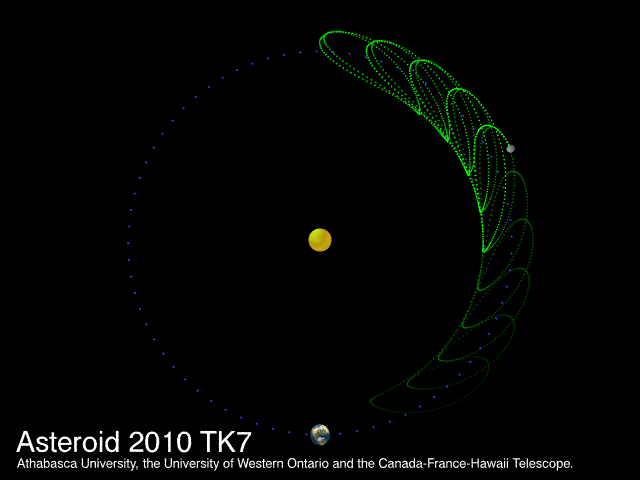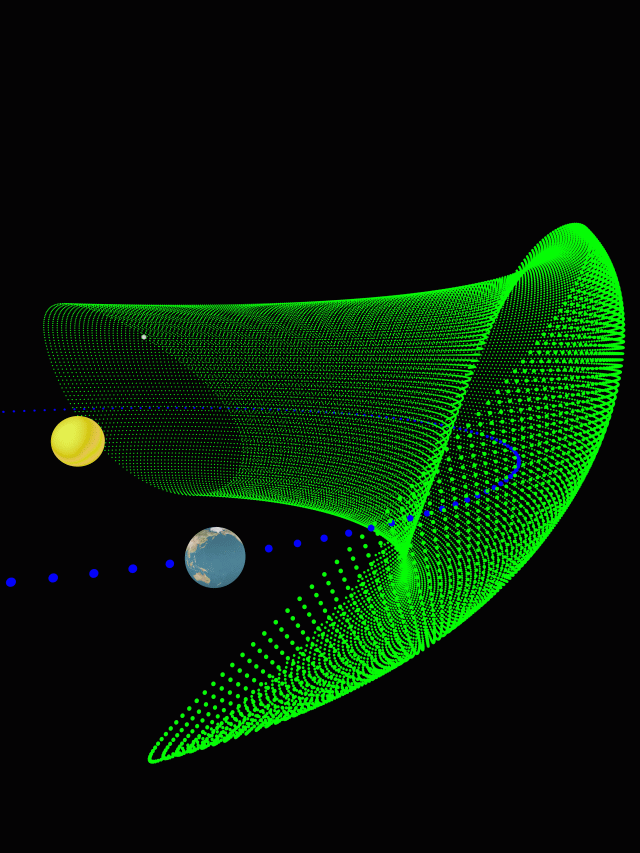(Animation: 8.8Mb MP4, 9.2Mb Windows AVI, 7.2Mb Quicktime MOV

Martin Connors
Centre for Science, Athabasca University, Athabasca AB CANADA
Paul Wiegert
Dept. of Physics and Astronomy, The University of Western Ontario, London ON CANADA
Christian Veillet
Canada-France-Hawaii Telescope, Kamuela HI USA
 |
In the July 28 2011 issue of the journal Nature , astronomers announce that the as-yet-unnamed near-Earth asteroid with the temporary designation 2010 TK7, shares the Earth's orbit with it. As the asteroid and the Earth both orbit the Sun, 2010 TK7 remains in step with our planet, remaining ahead of us as seen from Earth.
Like one of a pair of dancers performing a complicated tango, the asteroid moves in an elaborate path that brings it sometimes closer and sometimes farther from our planet. The Earth and the asteroid remain in sync however, with the asteroid always preceeding the Earth as they both move around the Sun.
That asteroids could perform such complicated motions while staying in step with their companion planets was first proposed by Joseph Louis Lagrange in 1772. The first asteroid discovered to have this property was asteroid 588 Achilles, spotted by Max Wolf in 1906, and which accompanies the giant planet Jupiter. As the largest planet in our Solar System weighing in at over 300 times the mass of the entire Earth, Jupiter is now known to have thousands of such asteroids. Frequently called "Trojan" asteroids because of the tradition of naming these bodies after the heroes of the Greek and Trojan War as immortalized by Homer in the Iliad and Odyssey, only the planets Jupiter, Neptune and Mars were known to harbour such objects until now.
 |
Asteroid 2010 TK7 is a near-Earth asteroid in the sense that its orbit takes it much closer to Earth than main belt asteroids ever do, but it does not constitute a threat to our planet. Quite the opposite in fact. Other NEAs move around the Sun in ways which are uncoordinated with our planet, and this allows for some degree of danger from collision. Because the motion of 2010 TK7 is in sync with that our planet the asteroid, like a good dancer, always neatly avoids blundering into its partner.
At its closest point to Earth, 2010 TK7 is still many times the distance to the Moon from us, much much further than other asteroids that occasionally pass near the Earth, like 2011 MD. In the next ten thousand years, 2010 TK7 will not approach us any closer than 20 million km, which is over 50 times the 384,000 km distance to the Moon.
Trojan asteroids are the best-known and studied asteroids of a class called "co-orbital asteroids", so-named because they can share a planet's orbit with it. What we call "Earth co-orbital asteroids" (or ECAs) here are asteroids in a 1:1 mean-motion resonance with the Earth. That means that they go around the Sun in the same amount of time as the Earth does, that is, one year. Though the Earth and the asteroids don't always move at the same speed at every instant, their average (or mean) motion is the same, hence the name 1:1 mean-motion resonance.
Most co-orbital asteroids are not confined ahead of or behind our planet the way Trojans are. Nonetheless, they have a distinct though subtle dynamical relationship with the Earth that the vast majority of near-Earth asteroids lack. For more information on co-orbital asteroids, see the links at the bottom of this page.
Asteroid 2010 TK7 was discovered by the Wide-field Infrared Survey Explorer (WISE) satellite in October 2010. Shortly after this, the possible co-orbital nature of the orbit of 2010 TK7 was pointed out by Martin Connors (Athabasca University in Alberta, Canada). Follow-up images of the asteroid were taken by Christian Veillet, then Director of the 3.6 meter Canada-France-Hawaii Telescope in Hawaii, to refine the asteroid's orbit once it became favorably placed in the night sky. Based on this new information, Paul Wiegert (The University of Western Ontario in Ontario, Canada) was able to perform computer simulations of the asteroid which confirmed the Trojan character of its motion.
Note: the following clips (and the previous images) are only illustrative of the orbits involved. In particular, the number of "loops" has been reduced in some for easier visibility, and the sizes of the Sun, Earth and the asteroid have been exaggerated for the same reason. As a result, the asteroid appears to pass much closer to the Earth than it does in reality.
Huh?!? Don't asteroids orbit the Sun? Is this one different? How can it do those weird loops? |
|
Asteroid 2010 TK7 is still in orbit around the Sun despite its unique relationship with the Earth. The asteroid is poised between the gravitational forces of the Sun and Earth (and the centrifugal/centripetal force as well). The Earth's grasp on it allows a significant amount of play however, like a dog on a long leash. The asteroid may wander around but remains restricted in how far it can go. Can you visualize the synchronized motion of both Earth and asteroid around the Sun? This might help. Remember that Earth, asteroid (and in some of these clips, the camera itself) are revolving around the Sun. This clip shows how the motion of Earth and asteroid around the Sun translates into these strange-looking loops. The first part shows the motion over a few years, the second part speeds up the clock to show the long-term motion (22 Mb MP4, 20 Mb Windows AVI, 13.8 Mb Quicktime MOV). The dots trailing the asteroid show the position of the asteroid relative to the moving Earth to try to illustrate the range allowed by the asteroid's "leash". |
| Still confused? Check out our Earth Trojan page for more. |
Note that this page is not actively maintained. Some information may be out of date.